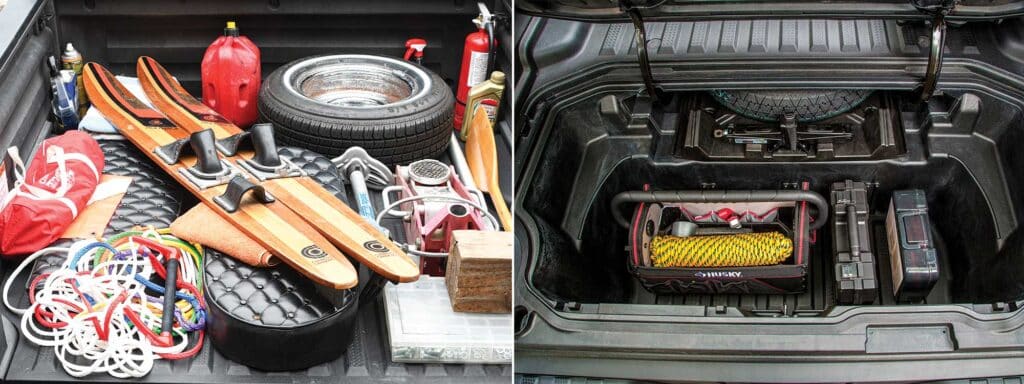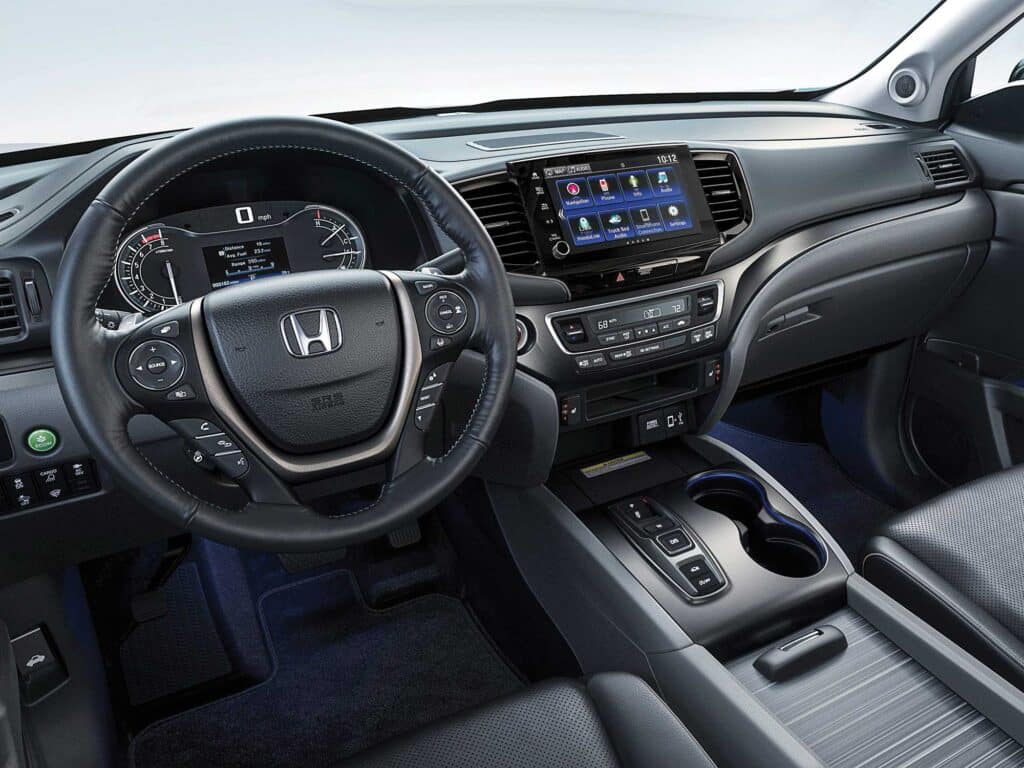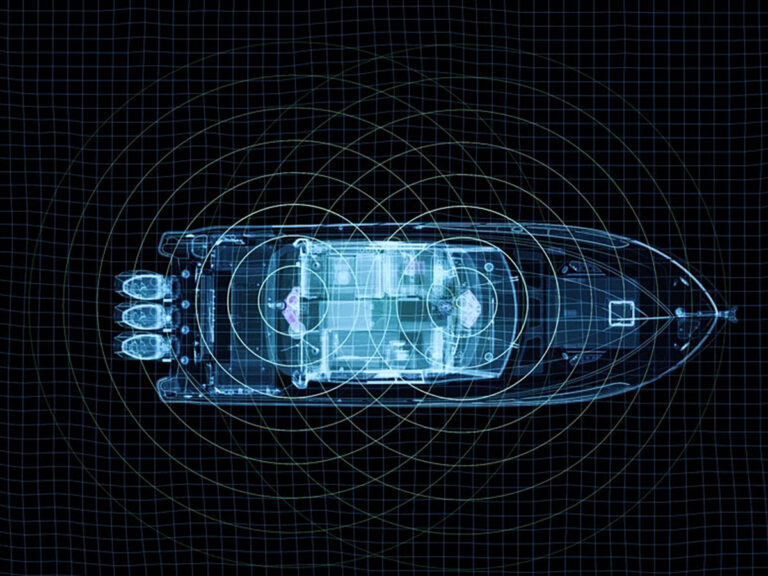
In their own peculiar way, unibody pickups are like the Rodney Dangerfield of towing—among serious trailer and hauling folks, they get no respect. The root of it might be that the popular full-size trucks (Ford F-150, Chevy 2500, RAM 3500, et al.), with their ladder frames and separate bodies and beds, model the architecture of the heavy hitters of American transportation—Freightliner, Kenworth and the like. They’re big. They’re burly. (And they’re often thirsty.) In contrast, unibody trucks are decidedly smaller and more car-like and lack the hauling chops of full-size pickups. As an example, the Honda Ridgeline Black Edition can tow a maximum of 5,000 pounds, compared with a maximum of 36,000 pounds for a GMC Sierra 3500 HD. Others, such as the Ford Maverick and Hyundai Santa Cruz, tow even less than the Ridgeline. Still, we wanted to see if a unibody could do the job, so we loaded up our 1970 V-8 ski boat, Red Flag, weighing 3,000 pounds (with the single-axle trailer), and headed for the High Sierra mountain range on the California-Nevada border.

What Defines a Real Truck?
After decades of towing and hauling with full-size trucks, we were curious how Honda’s renegade pickup compares, in practice on the road. Here’s our experience. This past fall, we charted a four-lake, 1,200-mile High Sierras tow trip with a V-8-powered inboard ski boat, a route we’ve covered numerous times with various truck/boat rigs. With passes over 8,000 feet, rarified atmospheric conditions, and grades as steep as 9 percent, the conditions are challenging. But our workload was light, as trailering goes; together, the estimated boat and trailer weight was 3,000 pounds—easier work for a full-size pickup. But what about for the second-generation Ridgeline, still one of the few unibody pickups available?
Sharing engineering with the Honda Pilot SUV, the Ridgeline differs in its availability in all-wheel-drive guise only (i-VTM4 in Honda’s parlance). A single-engine specification is likewise available, a transversely mounted 3.5-liter aluminum V-6 with overhead camshafts, four valves per cylinder, and variable valve timing and lift (i-VTEC), producing 280 hp at 6,000 rpm and 262-pound-foot torque at a lofty 4,700 rpm. (Extracting such performance from a relatively small engine requires high engine speeds.) EPA-rated fuel economy is 18 mpg city, 24 mpg highway and 21 mpg combined; towing through the city, desert and mountains, we observed an average 19 mpg for the trip—excellent for any tow rig. An idle-stop feature kills the engine when the truck is stopped, such as at stoplights. This can be defeated as desired, such as when the engine needs to keep running to supply power to the 400-watt AC outlet in the bed.
The engine is backed by a nine-speed automatic, with steering-wheel-mounted paddle shifters for manual control. We accelerated from zero to 60 mph in around 12 seconds while towing. Compare that to 7 seconds without the boat. At 60 mph, at light throttle, the engine turns just 1,800 rpm—on par with a much larger V-8. But when we needed to make a quick pass, the Ridgeline was clearly no muscle-bound Power Stroke turbodiesel. Despite its on-demand AWD system, neither does the Ridgeline enable an easy pull up a steep launch ramp at high altitude, in part due to a lack of low-range gears that are occasionally useful on crummy surface conditions there. In sum, the Ridgeline’s powertrain is smooth, flexible and versatile for light to medium towing work.

Civil and Versatile
While moderate in capability, the Ridgeline makes up ground in civility. For instance, compared with full-size pickups, its overall size is refreshing. Here is a “normal-size” vehicle that can be used for everyday driving and parked with relative ease, and seats five, with towing and hauling capability and lockable storage under the floor of the bed. In our case, this was inaccessible due to a short trailer tongue that blocked the dual-function tailgate from either flipping down or swinging open like a door (your choice normally). The only way to utilize this feature was to unhitch the trailer and pull the truck forward. We didn’t bother. But if we had, underneath the bed is a locking 7.3-cubic-foot (54.6–gallon) well that can double as an ice chest, six waterproof speakers for the 540-watt sound system, and both 12-volt DC and 115-volt AC outlets. (That’s a lot; the Beatles had only 700 watts at Shea Stadium in 1965.)

In another compromise, the bed is just 5 feet, 4 inches long, obviously limiting what it can carry; however, the Ridgeline’s payload is 3/4-ton, and eight stout steel tie-down rings are included
—a high- and low-mounted ring at each inside corner. More companies should follow suit. Another detriment to Honda’s trick dual-level bed is its height—the bed is 3 feet above ground level. That’s great for loading potted plants or coolers, but when something tall and heavy is being hauled—for instance, a gas-grill barbecue—it must first be lifted to bed height, and then the center of mass is higher off the ground.

Comfortable Cabin
Inside, we found the Ridgeline Black Edition well-appointed and nicely styled and assembled. The bucket seats (10-way adjustable for the driver, four-way for the passenger) are perforated-leather-covered, offering excellent comfort. The front seats are additionally heated and ventilated. The driver ergonomics are good, as is outside visibility. From our standpoint on this trip, detriments included a small navigation screen (isolated within a larger 9-inch color touchscreen); a larger map area would allow easier route following with less pinching and dragging, zooming, and stretching of map imagery.
The three-passenger rear compartment is flexible, with a 60/40 split-folding bench seat that allows part storage, part passenger accommodations. The seats feature steel supports that automatically swing into position when the bases are lowered. Easy to use, they’re a win. Rear-seat passengers also get their own air-conditioning outlets (like the front, which are filtered and humidity-controlled) and a pair of USB ports. The rear window has a sliding center section, controllable from a switch located on the ceiling above the driver; it’s seriously handy when you and your buddy are yelling at each other during boat launching and retrieval.
The transmission controls are found on the center console, and include separate switches—all different shapes, which we found problematic to use intuitively—for park, reverse, neutral and drive/sport. The vehicle lacks low-range gears and, despite being equipped with a Class III hitch receiver accompanied by a seven-pin connector, also lacks a brake controller. Oddly, the Ridgeline, despite its electronic push-button transmission controls, uses a manual, foot-operated parking brake instead of a now-typical electronic parking brake. This complicates the subtle nuances required for trailer hitching and boat retrieval. Fortunately, though, a color backup camera with dynamic guidelines allows for reversing to the trailer coupler with nearly pinpoint accuracy.

Ridgeline on the Road
Long-wheelbase vehicles tend to ride better and tow better, and in this regard, the Ridgeline, despite its modest 125.2-inch wheelbase and our short single-axle trailer, acquitted itself well. The turning diameter of the truck is 43.3 feet—11 percent less than, say, a full-size Toyota Tundra CrewMax short bed with its 48.6-foot turning diameter. Also, the Ridgeline’s fairly narrow (as trucks go) 78.6-inch width made navigating narrow roads easier, a point we appreciated when encountering one ancient winding lake road.
The 18-inch black-finished aluminum wheels and reasonably sized 245/60R18 Firestone Destination LE2 tires contributed to decent ride quality. As measured at 60 mph, interior noise levels on the highway ranged from 76 dB to 87 dB (your readings might vary), depending on conditions. Like most new vehicles, the Ridgeline’s cabin is agreeably quiet on perfect pavement, and less so over rough surfaces. Also intruding in the latter conditions was our two-piece drawbar, whose height-adjustable section introduced an additional rattle point. (We needed an anti-rattle kit!) In contrast to big body-on-frame trucks, the noise and inertia associated with this setup could be heard and felt profoundly in the cabin. We recommend a quality hitch setup and great trailer suspension if towing with a Ridgeline.
The farther away we got from the city, the higher the gas prices crept—that is, until we crossed the California border into the fiscal safety of Nevada. Observed high prices in the California Sierras approached $8 per gallon, making the Ridgeline’s good mileage and happiness with regular unleaded a plus. Although, unlike some big trucks with their nearly 600-mile fuel range, the Ridgeline’s 19.5-gallon tank took us less than 400 miles between fill-ups.
Read Next: Towing-Vehicle Tech That Assists Boaters

Easy Driver
For many recreational boaters—“trailer boat” specialists, in particular—the Ridgeline will serve admirably. As easy as a traditional crossover or midsize SUV to drive, it’s still technically a pickup, and offers the creative dual-level lockable storage, speakers, and power outlets in back. That’s good for soggy wetsuits and towels, smelly fish and tackle, and various hard items such as anchors and chains, boards and skis, toolboxes, and the like.
Altogether, positives for us included the interior comfort, easy handling, favorable size, and overall drivability. We would really like a larger navigation touchscreen, better sound insulation, a 1- to 2-foot-longer bed, a bigger fuel tank, and more power, such as from a turbo V-6. To this point, for those with larger boats, the Ridgeline’s moderate towing capacity will eliminate it from tow-vehicle consideration. But for us in the High Sierras this past summer, it proved just right for flight.









